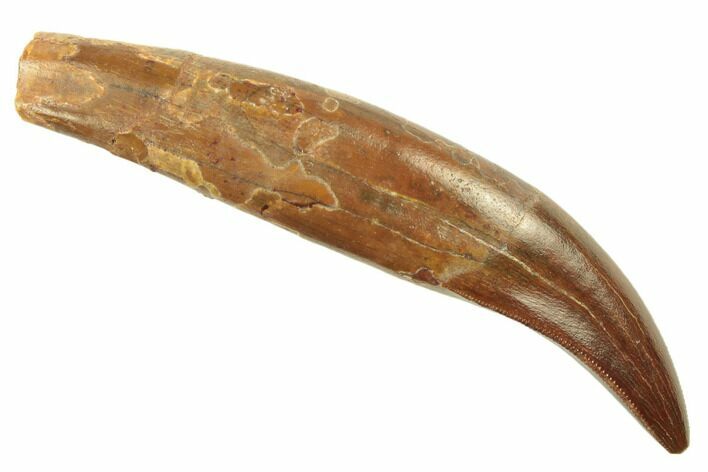This Specimen has been sold.
2.4" Rooted Theropod Dinosaur (Deltadromeus?) - Kem Kem Beds
This is an exceptional, 2.4" long, rooted theropod tooth from the Kem Kem Beds near Taouz, Morocco. The tooth is very well preserved with excellent enamel, fine serrations and an original root. It is very difficult to find rooted teeth, and this one only has a single repaired crack near the base of the root.
The crown of the tooth is .95" long and is much more round in cross-section than the common Abelisaurid teeth found in the formation. It represents one of the rarer theropod teeth found in the formation and could be from Deltadromeus.
Deltadromeus is a poorly understood theropod originally described from the Kem Kem Beds. No skull material has ever been found so assigning teeth to this genus is a best guess. This tooth doesn't match any of the other known theropods from the formation (Carcharodontosaurus, Abelisaurids, Spinosaurus, Dromaeosaurs) so out of the known dinosaurs that leaves Deltadromeus. Many studies published since the original description of Deltadromeus have considered it to be a ceratosaur, although different studies disagree on what kind of ceratosaur. One 2003 study suggested it was a member of the Noasauridae, though others have found it to be more primitive, possibly related to the primitive ceratosaurs Elaphrosaurus and Limusaurus. There is also speculation it might be a primitive Tyrannosaur.
The crown of the tooth is .95" long and is much more round in cross-section than the common Abelisaurid teeth found in the formation. It represents one of the rarer theropod teeth found in the formation and could be from Deltadromeus.
Deltadromeus is a poorly understood theropod originally described from the Kem Kem Beds. No skull material has ever been found so assigning teeth to this genus is a best guess. This tooth doesn't match any of the other known theropods from the formation (Carcharodontosaurus, Abelisaurids, Spinosaurus, Dromaeosaurs) so out of the known dinosaurs that leaves Deltadromeus. Many studies published since the original description of Deltadromeus have considered it to be a ceratosaur, although different studies disagree on what kind of ceratosaur. One 2003 study suggested it was a member of the Noasauridae, though others have found it to be more primitive, possibly related to the primitive ceratosaurs Elaphrosaurus and Limusaurus. There is also speculation it might be a primitive Tyrannosaur.
Comes with a floating frame display case.
The Kem Kem Group
The Kem Kem Group, also known as the Kem Kem Beds, is a significant geological formation located in southeastern Morocco, specifically in the region of the Anti-Atlas Mountains. This formation dates back to the late Cretaceous period, approximately 95 million years ago. The Kem Kem Beds are primarily composed of sandstone, siltstone, and claystone, interspersed with various sedimentary features that indicate a fluvial to deltaic environment.
The Kem Kem Group is renowned for its rich fossil deposits, which include a diverse array of prehistoric fauna. It has yielded a wide variety of dinosaur fossils, including theropods like Spinosaurus and Carcharodontosaurus, as well as large Sauropod dinosaurs such as Rebbachisaurus. Additionally, the beds are home to many other fossilized creatures, including crocodiles, pterosaurs, fish, and a range of invertebrates.
Paleontologists consider the Kem Kem Group an important site for studying late Cretaceous ecosystems and the evolution of vertebrate life. The fossils found in this region have provided valuable insights into the diversity and behavior of prehistoric species, making it a key location for both scientific research and fossil collecting. The striking landscapes of the Kem Kem Beds, with their colorful rock formations and dramatic geological features, also attract geologists and tourists interested in the natural history of the area.
A paper on this assemblage can be found at: Vertebrate assemblages from the early Late Cretaceous of southeastern Morocco: An overview
The Kem Kem Group, also known as the Kem Kem Beds, is a significant geological formation located in southeastern Morocco, specifically in the region of the Anti-Atlas Mountains. This formation dates back to the late Cretaceous period, approximately 95 million years ago. The Kem Kem Beds are primarily composed of sandstone, siltstone, and claystone, interspersed with various sedimentary features that indicate a fluvial to deltaic environment.
The Kem Kem Group is renowned for its rich fossil deposits, which include a diverse array of prehistoric fauna. It has yielded a wide variety of dinosaur fossils, including theropods like Spinosaurus and Carcharodontosaurus, as well as large Sauropod dinosaurs such as Rebbachisaurus. Additionally, the beds are home to many other fossilized creatures, including crocodiles, pterosaurs, fish, and a range of invertebrates.
Paleontologists consider the Kem Kem Group an important site for studying late Cretaceous ecosystems and the evolution of vertebrate life. The fossils found in this region have provided valuable insights into the diversity and behavior of prehistoric species, making it a key location for both scientific research and fossil collecting. The striking landscapes of the Kem Kem Beds, with their colorful rock formations and dramatic geological features, also attract geologists and tourists interested in the natural history of the area.
A paper on this assemblage can be found at: Vertebrate assemblages from the early Late Cretaceous of southeastern Morocco: An overview
SPECIES
Deltadromeus?
LOCATION
Taouz, Kem Kem Basin, Morocco
FORMATION
Kem Kem Beds
SIZE
2.4" long, .95" Crown
CATEGORY
SUB CATEGORY
ITEM
#195819
We guarantee the authenticity of all of our specimens.
 Reviews
Reviews













